tow OLDSMOBILE SILHOUETTE 1998 Owners Manual
[x] Cancel search | Manufacturer: OLDSMOBILE, Model Year: 1998, Model line: SILHOUETTE, Model: OLDSMOBILE SILHOUETTE 1998Pages: 444, PDF Size: 23.2 MB
Page 19 of 444
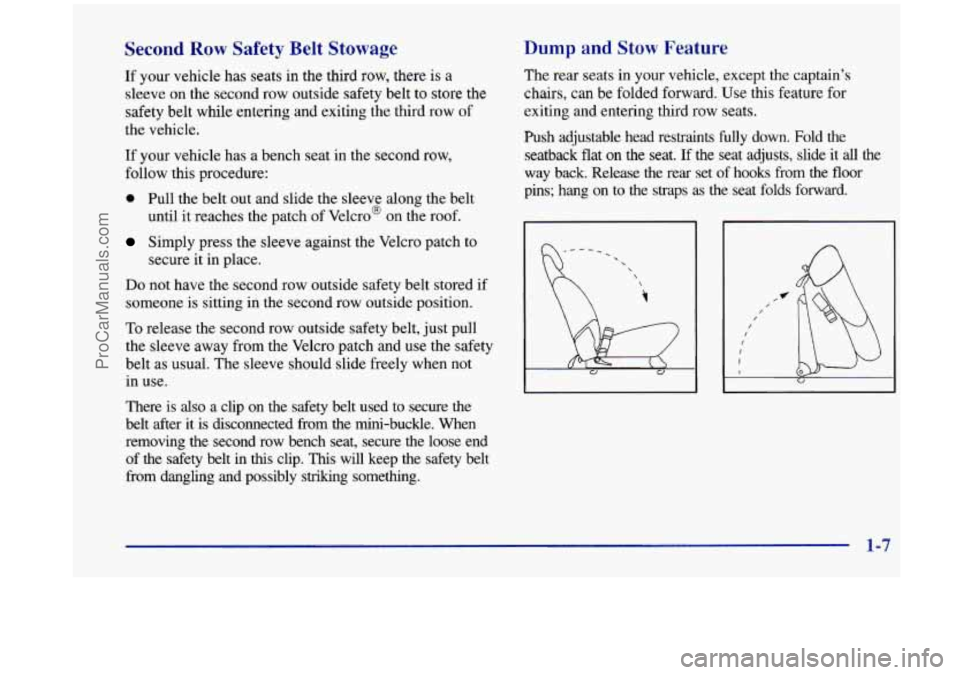
Second Row Safety Belt Stowage
If your vehicle has seats in the third row, there is a
sleeve on the second row outside safety belt to store the
safety belt while entering and exiting the third
row of
the vehicle.
If your vehicle has a bench seat in the second row,
follow this procedure:
0 Pull the belt out and slide the sleeve along the belt
until it reaches the patch of Velcro@ on the roof.
Simply press the sleeve against the Velcro patch to
bo not have the second row outside safety belt stored if
someone is sitting in the second row outside position.
To release the second row outside safety belt, just pull
the sleeve away from the Velcro patch and use the safety
belt as usual. The sleeve should slide freely when not
in use. secure it
in place.
There is
also a clip on the safety belt used to secure the
belt after it is disconnected
from the mini-buckle. When
removing the second row bench seat, secure the loose end
of the safety belt in this clip.
This will keep the safety belt
from dangling and possibly striking something.
Dump and Stow Feature
The rear seats in your vehicle, except the captain’s
chairs, can be folded forward. Use this feature for
exiting and entering third row seats.
Push adjustable head restraints fully down. Fold the seatback
flat on the seat. If the seat adjusts, slide it all the
way back. Release the rear set of hooks from the floor
pins; hang on to the straps as the seat folds forward.
I I I I I U
1-7
ProCarManuals.com
Page 23 of 444
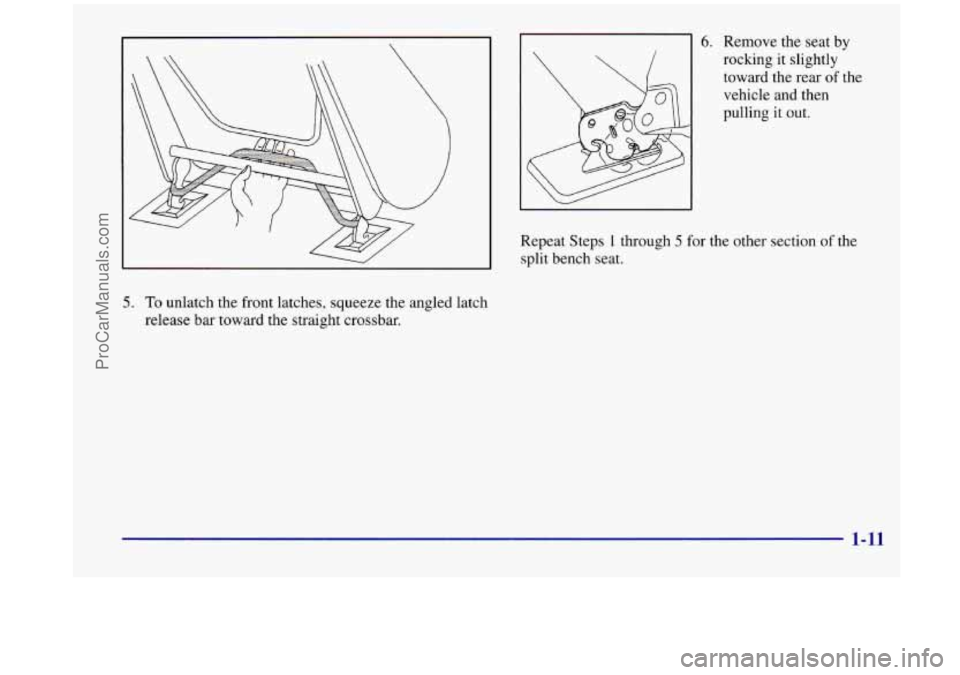
L
Repeat Steps 1 through 5 for the other section of the
split bench seat.
5. To unlatch the front latches, squeeze the angled latch
release bar toward the straight crossbar.
6. Remove the seat by
rocking it slightly
toward the rear
of the
vehicle and then
pulling it out.
1-11
ProCarManuals.com
Page 24 of 444

Replacing the Split Bench Sections
Don’t put the sections of the bench seat in so they face
rearward because they won’t latch that way. If
you want
more storage room behind the seat, adjust each section
by sliding it forward.
The split benches have seat position labels, located on
the back
of each seat, showing where the seat must go.
Follow that diagram.
0 The left (40) section of the 40/60 split bench uses the
A and B sets of floor cups.
the
C and D sets of floor cups.
and
H sets of floor cups.
and
J sets of floor cups.
0 The right (60) section of the 40/60 split bench uses
0 The left section of the 50/50 split bench uses the G
0 The right section of the 50/50 split bench uses the I
1. Squeeze the angled gray bar toward the solid gray
crossbar while placing the front hooks of the bench
seat onto the front two floor pins.
See “Seat Controls” in the beginning of this section for
more details. The seat must be placed in the proper
location for the legs to attach correctly.
Make sure the seat is in the full rear position before
beginning this procedure.
1-12
ProCarManuals.com
Page 30 of 444
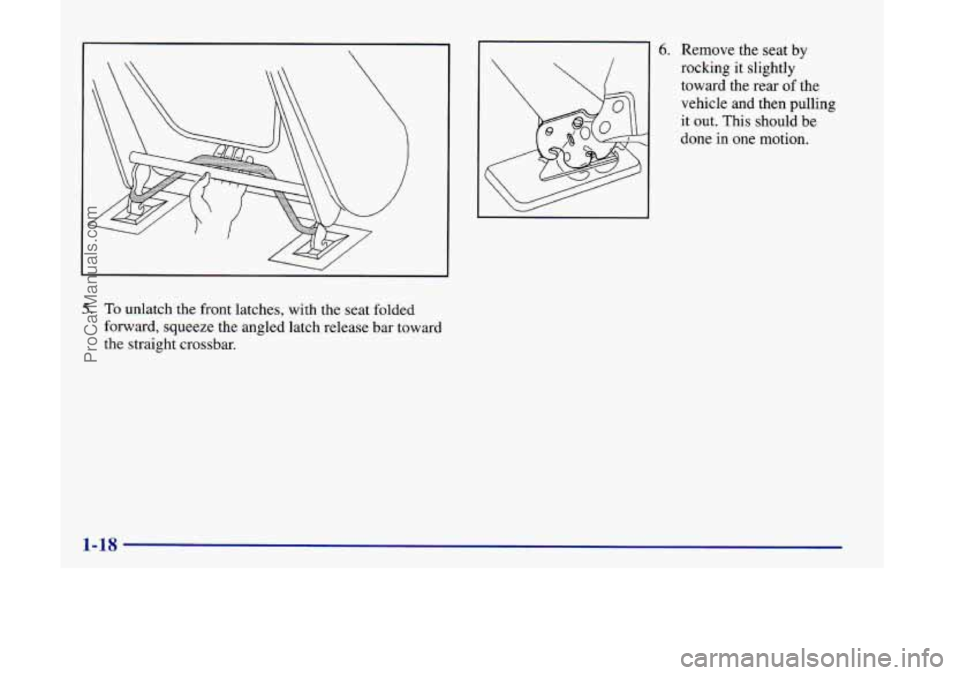
5. To unlatch the front latches, with the seat folded
forward, squeeze the angled latch release bar toward
the straight crossbar.
6. Remove the seat by
rocking it slightly
toward the rear
of the
vehicle and then pulling
it
out. This should be
done in one motion.
1-18
ProCarManuals.com
Page 31 of 444

Replacing the Bucket Seats
Don’t put the seats in so they face rearward because they
won’t latch that way. If you want more storage room
behind the seat, adjust the seat by sliding it forward.
The bucket seats have seat position labels, located on the
back
of the seat, showing where the seat must go. Follow
that diagram. See “Seat Controls” in the beginning of
this
section for more details. The seat must be placed in the
proper location for the legs
to attach correctly.
RIGHT
ONLY seats that don’t have the built-in child
restraint option fit only in the right location of either
row, the
E and F or I and J sets of floor cups.
The CENTER
OR LEFT seat fits in the center location
or in either left location, the
A and B, C and D or G
and H sets of floor cups.
The
LEFT ONLY seats that don’t have the built-in child
restraint option fit only in the left location of either row,
the
A and B or G and H sets of floor cups.
RIGHT ONLY seats that have the built-in child restraint
option fit only
in the right location of the second row,
the
E and F sets of floor cups.
LEFT ONLY seats that have the built-in child restraint
option fit only
in the left location of the second row, the
A and B sets of floor cups.
Make sure the seat is in the full rear position before
beginning this procedure.
1. With the seat folded, squeeze the angled gray bar
toward the solid gray crossbar while placing the
front hooks of the bench seat
onto the front two
floor pins.
To do this,
the seat will
need to be angled
so that
the front hooks clear the
floor pins.
1-19
ProCarManuals.com
Page 56 of 444
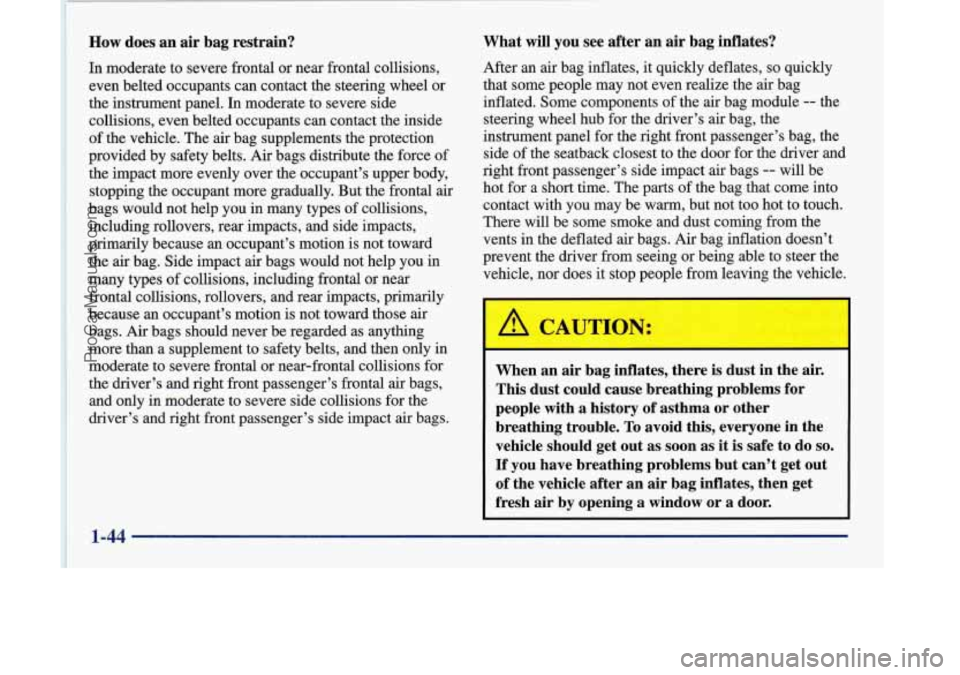
How does an air bag restrain?
In moderate to severe frontal or near frontal collisions,
even belted occupants can contact the steering wheel or
the instrument panel. In moderate
to severe side
collisions, even belted occupants can contact the inside
of the vehicle. The
air bag supplements the protection
provided by safety belts. Air bags distribute the force of
the impact more evenly over the occupant’s upper body,
stopping the occupant more gradually. But the frontal
air
bags would not help you in many types of collisions,
including rollovers, rear impacts, and side impacts,
primarily because an occupant’s motion is not toward
the air bag. Side impact air bags would not help you in
many types of collisions, including frontal or near
’ frontal collisions, rollovers, and rear impacts, primarily
because an occupant’s motion is not toward those air
bags.
Air bags should never be regarded as anything
more than a supplement to safety belts, and then only in
moderate to severe frontal or near-frontal collisions for
the driver’s and right front passenger’s frontal air bags,
and only in moderate to severe side collisions for the
driver’s and right front passenger’s side impact air bags.
What will you see after an air bag inflates?
After an air bag inflates, it quickly deflates, so quickly
that some people may not even realize the air bag
inflated. Some components of the air bag module
-- the
steering wheel hub for the driver’s
air bag, the
instrument panel for the right front passenger’s bag, the
side of the seatback closest to the door for the driver and
right front passenger’s side impact air bags
-- will be
hot for a short time. The parts of the bag that come into
contact with you may be warm, but not too hot to touch.
There will be some smoke and dust coming from the
vents in the deflated air bags. Air bag inflation doesn’t
prevent the driver from seeing or being able to steer the
vehicle, nor does it stop people from leaving the vehicle.
When an air bag inflates, there is dust in the air.
This dust could cause breathing problems for
people with
a history of asthma or other
breathing trouble. To avoid this, everyone in the
vehicle should get out
as soon as it is safe to do so.
If you have breathing problems but can’t get out
of the vehicle after an air bag inflates, then get
fresh air by opening a window or a door.
1-44
ProCarManuals.com
Page 58 of 444

If your vehicle ever gets into a lot of water -- such as
water up to the carpeting or higher
-- or if water enters
your vehicle and soaks the carpet, the air bag controller
can be soaked and ruined.
If this ever happens, and then
you start your vehicle, the damage could make the
frontal and side impact air bags inflate and safety belt
pretensioners activate, even if there’s no crash. You
would have to replace the air bags, all the sensors and
related parts, parts of the safety belt system and parts
of
the driver and right front passenger’s seatbacks. If your
vehicle is ever in a
flood, or if it’s exposed to water that
soaks the carpet, you can avoid needless repair costs by
turning off the vehicle immediately. Don’t let anyone
start the vehicle, even to tow it, unless the battery cables
are first disconnected.
Servicing Your Air Bag-Equipped Vehicle
Air bags affect how your vehicle should be serviced.
There are parts of the air bag systems in several places
around your vehicle. Your retailer and the Silhouette
Service Manual have information about servicing your
vehicle and the
air bag systems. To purchase a service
manual, see “Service and Owner Publications” in
the Index.
For up to 10 minutes after the ignition key is
, turned off and the battery is disconnected, an air
bag can still inflate during improper service. You
can be injured if you are close to an air bag when
it inflates. Avoid wires wrapped with yellow tape
or yellow connectors. They are probably part of
the air bag systems. Be sure
to follow proper
service procedures, and make sure the person
performing work for you is qualified to do
so.
~~ ~~
The air bag systems do not need regular maintenance.
1-46
ProCarManuals.com
Page 83 of 444
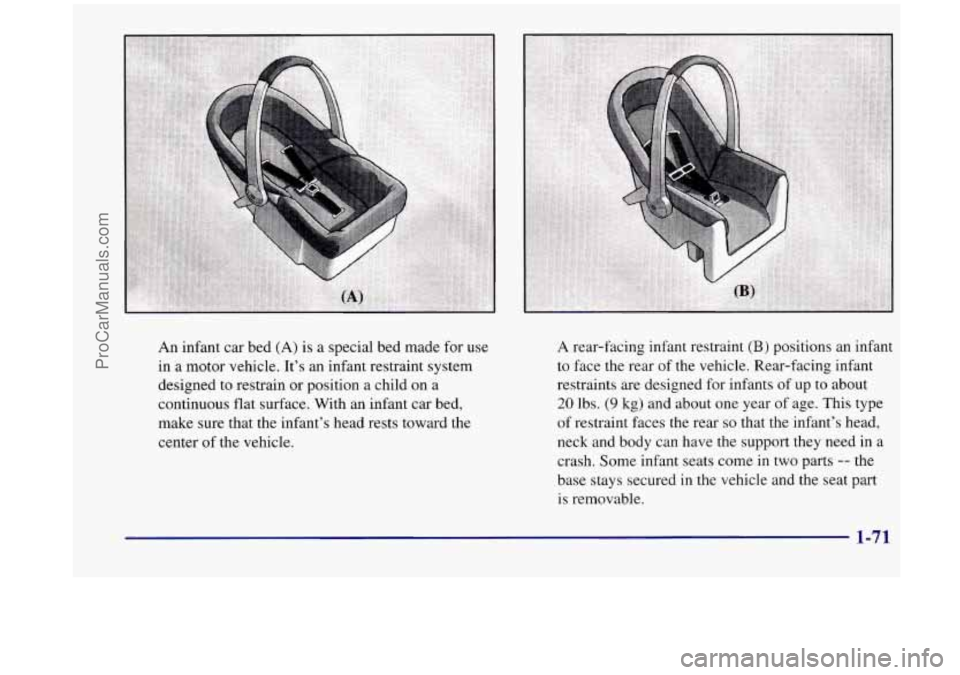
An infant car bed (A) is a special bed made for use
in a motor vehicle. It’s an infant restraint system
designed to restrain or position a child
on a
continuous flat surface. With an infant car bed,
make sure that the infant’s head rests toward the
center of the vehicle.
A rear-facing infant restraint (B) positions an infant
to face the rear of the vehicle. Rear-facing infant
restraints are designed for infants of up to about
20 lbs. (9 kg) and about one year of age. This type
of restraint faces the rear
so that the infant’s head,
neck and body can have the support they need in a
crash. Some infant seats come in two parts
-- the
base stays secured in the vehicle and the seat part
is removable.
1-71
ProCarManuals.com
Page 99 of 444
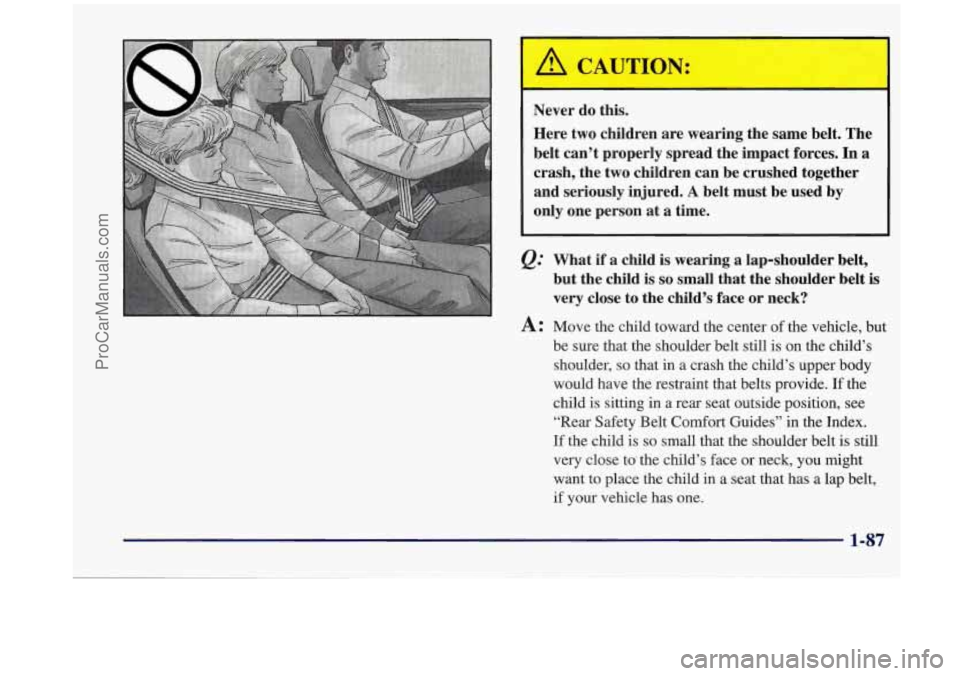
Never do this.
Here two children are wearing the same belt. The
belt can't properly spread the impact forces. In a
crash, the two children can be crushed together
and seriously injured.
A belt must be used by
only one person at a time.
Q: What if a child is wearing a lap-shoulder belt,
but the child is
so small that the shoulder belt is
very close to the child's face or neck?
A: Move the child toward the center of the vehicle, but
be sure that the shoulder belt still is on the child's
shoulder, so that in a crash the child's upper body
would have the restraint that belts provide. If the
child is sitting in a rear seat outside position, see
"Rear Safety Belt Comfort Guides" in the Index.
If the child is
so small that the shoulder belt is still
very close to. the child's face or neck, you might
want to place the child in a seat that has a lap belt,
if your vehicle has one.
1-87
ProCarManuals.com
Page 106 of 444

Door Locks
I-
Unlocked doors can be dangerous.
Passengers
-- especially children -- can easily
open the doors and fall out. When a door is
locked, the inside handle won’t open it.
Outsiders can easily enter through an unlocked
door when you slow down
or stop your vehicle.
This may not be
so obvious: You increase the
chance of being thrown out of the vehicle in
a
crash if the doors aren’t locked. Wear safety belts
properly, lock your doors, and you will be far
better
off whenever you drive your vehicle. There
are several ways to lock and unlock your vehicle.
From the outside, use your key or the remote lock
control transmitter (if your vehicle
has this option).
To unlock either front door from the outside with the
key, insert the key and turn it toward the front
of
the vehicle.
You can lock either front door from the outside with
your key by inserting
and turning it toward the rear of
the vehicle.
ProCarManuals.com